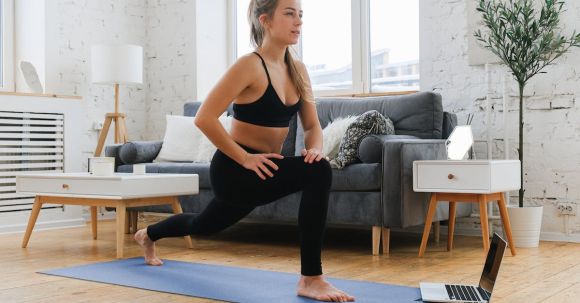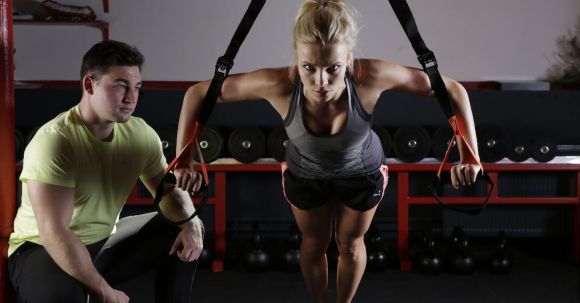Are you looking to take your athletic performance to the next level? If so, then it's time to consider sports-specific training. This type of training focuses on improving the skills and abilities necessary for your particular sport, helping you to excel on the field, court, or track. In this article, we will explore the benefits of sports-specific training and provide you with some tips to get started.
Author: fit-on
Creating a home gym doesn't have to break the bank. With a little creativity and resourcefulness, you can set up a functional and affordable workout space right in the comfort of your own home. In this article, we will explore some practical tips on how to create a home gym on a budget.
1. Find a Suitable Space
The first step in creating a home gym on a budget is to find a suitable space in your home. It could be a spare room, a corner of your living room, or even your garage. The key is to choose a location that is well-lit and has enough space for your workout equipment.2. Assess Your Fitness Goals
Before investing in any equipment, it's important to assess your fitness goals. Determine what type of exercises you enjoy and what equipment you will need to achieve your goals. This will help you avoid unnecessary purchases and focus on what is essential for your workouts.3. Start with the Basics
When creating a home gym on a budget, it's best to start with the basics. Invest in a few versatile and multi-functional pieces of equipment that can be used for a variety of exercises. Some examples include resistance bands, dumbbells, and a stability ball. These items are relatively affordable and can provide a full-body workout.4. Look for Secondhand Equipment
One of the best ways to save money when creating a home gym is to look for secondhand equipment. Check online marketplaces, garage sales, and local classifieds for used exercise equipment. You'll often find great deals on treadmills, exercise bikes, and weightlifting equipment that are still in excellent condition.5. Get Creative with DIY Solutions
Don't be afraid to get creative and think outside the box when setting up your home gym. Look for DIY solutions that can help you save money. For example, you can use milk jugs filled with water or sand as weights, or use a sturdy chair for step-ups and tricep dips. The possibilities are endless!6. Utilize Bodyweight Exercises
Another cost-effective way to create a home gym is to utilize bodyweight exercises. Exercises like push-ups, squats, lunges, and planks require no equipment and can be done anywhere. By incorporating bodyweight exercises into your routine, you can effectively target multiple muscle groups without the need for expensive equipment.7. Consider Subscription-based Workout Apps
If you're looking for variety in your workouts but don't want to invest in expensive equipment, consider subscribing to workout apps. Many fitness apps offer a wide range of workouts that can be done with minimal equipment. These apps often have free trial periods, so you can test them out before committing to a subscription.8. Stay Motivated and Consistent
Creating a home gym on a budget is just the first step. To make the most of your investment, it's important to stay motivated and consistent with your workouts. Set realistic goals, create a schedule, and hold yourself accountable. Remember, consistency is key when it comes to achieving fitness results. In conclusion, creating a home gym on a budget is not only possible but also a smart investment in your health and well-being. By finding a suitable space, starting with the basics, looking for secondhand equipment, getting creative with DIY solutions, utilizing bodyweight exercises, considering subscription-based workout apps, and staying motivated and consistent, you can create a functional and affordable home gym that meets your fitness goals. So, what are you waiting for? Start building your home gym today!
In today's fast-paced world, finding time to hit the gym can be a challenge. But guess what? You don't have to! With the right home exercises, you can transform your body and achieve your fitness goals without ever leaving the comfort of your own home. No more excuses, let's get started!
1. The Power of Bodyweight Exercises
Who needs fancy gym equipment when you have the power of your own bodyweight? Push-ups, squats, lunges, and planks are all fantastic exercises that can help you build strength and tone your muscles. Plus, you can do them anywhere, anytime. Start with three sets of 10 reps for each exercise and gradually increase as you get stronger.2. Get Your Heart Pumping with Cardio
Cardiovascular exercises are essential for burning calories and improving your overall fitness. Jumping jacks, high knees, burpees, and mountain climbers are all great options that require minimal space and no equipment. Aim for at least 20 minutes of cardio three times a week to get your heart pumping and your metabolism revving.3. Resistance Training with Resistance Bands
Resistance bands are a versatile and affordable investment that can take your home workouts to the next level. They come in different resistance levels, allowing you to gradually increase the challenge as you get stronger. Use them for exercises like bicep curls, tricep extensions, lateral raises, and glute bridges. Feel the burn and watch your muscles grow!4. Yoga for Strength and Flexibility
Don't underestimate the power of yoga. Not only does it improve strength and flexibility, but it also promotes relaxation and reduces stress. Incorporate yoga into your home exercise routine by following online videos or joining virtual yoga classes. Whether you're a beginner or an experienced yogi, there's a practice for everyone.5. HIIT for Maximum Results
High-Intensity Interval Training (HIIT) is a time-efficient workout method that combines short bursts of intense exercise with brief recovery periods. This type of workout not only burns a significant amount of calories but also keeps your metabolism elevated long after you're done exercising. Try exercises like squat jumps, burpees, and mountain climbers for a HIIT workout that will leave you sweaty and satisfied.6. Core Strengthening with Pilates
A strong core is the foundation for a healthy and fit body. Pilates is a fantastic way to strengthen your core muscles and improve your posture. With exercises like the hundred, plank, and side plank, you'll be on your way to a stronger and more defined midsection. Plus, Pilates also works on your flexibility and overall body alignment.7. Stay Consistent and Track Your Progress
Consistency is key when it comes to transforming your body. Create a schedule and stick to it. Set realistic goals and track your progress to stay motivated. Whether it's writing down your workouts in a journal or using a fitness app to monitor your performance, keeping track of your achievements will help you stay on track and see how far you've come. In conclusion, transforming your body doesn't require an expensive gym membership or fancy equipment. With the right home exercises, you can achieve remarkable results from the comfort of your own home. Remember to focus on bodyweight exercises, incorporate cardio, resistance training, yoga, HIIT, and core strengthening into your routine. Stay consistent, track your progress, and most importantly, have fun on your fitness journey. The only limit is your dedication and determination. So, what are you waiting for? Start transforming your body today!
Losing weight is a common goal for many people, but finding the right weight loss program can be challenging. With so many options available, it's important to choose a program that not only helps you shed pounds but also ensures lasting results. In this article, we will explore some of the best weight loss programs that are proven to deliver long-term success.
1. The Mediterranean Diet: More than just a diet, the Mediterranean lifestyle focuses on a balanced and nutritious way of eating. This program emphasizes whole foods such as fruits, vegetables, whole grains, lean proteins, and healthy fats like olive oil. Numerous studies have shown that the Mediterranean diet is not only effective for weight loss but also reduces the risk of various chronic diseases.
2. Intermittent Fasting: This eating pattern involves alternating periods of fasting and eating. There are several different methods of intermittent fasting, but the most popular one is the 16/8 method, where you fast for 16 hours and eat within an 8-hour window. Intermittent fasting has been shown to promote weight loss by reducing calorie intake and boosting metabolism.
3. The DASH Diet: Originally developed to lower blood pressure, the DASH (Dietary Approaches to Stop Hypertension) diet has gained popularity as a weight loss program. The DASH diet emphasizes fruits, vegetables, whole grains, lean proteins, and low-fat dairy products while limiting saturated fats, sugary drinks, and processed foods. This program not only helps with weight loss but also improves overall heart health.
4. The Weight Watchers Program: Weight Watchers is a well-known weight loss program that focuses on a balanced approach to eating. It assigns points to different foods based on their nutritional value, and participants are given a certain number of points to consume each day. The program also promotes physical activity and provides support through group meetings or online forums. Weight Watchers has been shown to be effective for long-term weight loss.
5. The Paleo Diet: The Paleo diet is based on the idea of eating like our ancestors did during the Paleolithic era. It focuses on whole, unprocessed foods such as lean meats, fish, fruits, vegetables, nuts, and seeds while excluding grains, dairy, legumes, and processed foods. This program can lead to weight loss by reducing calorie intake and eliminating processed foods that often contribute to weight gain.
6. The Flexitarian Diet: The Flexitarian diet is a flexible approach to eating that emphasizes plant-based foods while still allowing for occasional meat consumption. This program encourages the inclusion of fruits, vegetables, whole grains, and legumes while limiting high-calorie, processed foods. The Flexitarian diet is not only effective for weight loss but also promotes overall health and sustainability.
In conclusion, when looking for a weight loss program that delivers lasting results, it's important to choose one that fits your lifestyle and preferences. The Mediterranean diet, intermittent fasting, the DASH diet, Weight Watchers, the Paleo diet, and the Flexitarian diet are all effective options that have been shown to promote long-term weight loss. Remember, consistency and making sustainable changes to your eating habits are key to achieving and maintaining your weight loss goals. So, start today and embark on a journey towards a healthier and happier you!
So you’ve mastered the basic yoga poses and are ready to take your practice to the next level. Welcome to the world of advanced yoga challenges! These challenging sequences are designed to push your physical and mental limits, helping you to deepen your practice and achieve new levels of strength and flexibility. In this article, we will explore some strategies to help you conquer the fit on advanced yoga challenges.
Set Clear Goals
Before embarking on an advanced yoga challenge, it is important to set clear goals for yourself. What do you hope to achieve from this challenge? Is it to develop more strength, enhance your flexibility, or master a particular pose? By setting specific goals, you can tailor your practice to suit your needs and track your progress along the way.Create a Consistent Practice Schedule
Consistency is key when it comes to conquering advanced yoga challenges. Set aside dedicated time each day to practice, even if it’s just 15 minutes. By creating a consistent practice schedule, you will build strength and endurance over time. Remember, progress takes time, so be patient with yourself and trust the process.Warm Up Properly
Before diving into an advanced yoga challenge, it is crucial to warm up your body properly. Dynamic stretching and gentle movements will help to increase blood flow, warm up your muscles, and prevent injury. Incorporate exercises such as sun salutations, cat-cow poses, and gentle twists into your warm-up routine.Embrace Modifications
Advanced yoga challenges often involve complex poses that may feel intimidating at first. Don’t be afraid to embrace modifications to make the poses more accessible to your body. Use props such as blocks, straps, or blankets to support your practice and gradually work towards the full expression of the pose. Remember, it’s not about achieving the perfect pose, but rather about exploring your edge and finding what feels right for your body.Focus on Breath and Mindfulness
As you navigate through an advanced yoga challenge, it is important to stay connected to your breath and cultivate mindfulness. Paying attention to your breath will help you stay present in the moment and maintain a steady rhythm throughout your practice. Mindfulness will also help you to tune into your body’s signals and make adjustments as needed.Seek Guidance from a Qualified Teacher
If you find yourself struggling with an advanced yoga challenge, don’t hesitate to seek guidance from a qualified teacher. They can provide valuable insights, correct alignment issues, and offer modifications tailored to your individual needs. A teacher can also help you establish a safe and supportive environment for your practice.Celebrate Small Victories
Conquering advanced yoga challenges is a journey, and it is important to celebrate your small victories along the way. Every time you reach a new milestone, whether it’s holding a pose for a few extra seconds or achieving a deeper stretch, acknowledge your progress and give yourself a well-deserved pat on the back. Remember, the joy is in the journey, not just the destination. In conclusion, conquering the fit on advanced yoga challenges requires commitment, patience, and a willingness to step out of your comfort zone. By setting clear goals, creating a consistent practice schedule, warming up properly, embracing modifications, focusing on breath and mindfulness, seeking guidance from a qualified teacher, and celebrating small victories, you can take your practice to new heights. So go ahead, level up, and embrace the challenge that awaits you on your yoga mat. Namaste!
Strongman competitions have gained immense popularity in recent years, attracting individuals from all walks of life who are eager to put their strength and power to the test. One of the most challenging events in these competitions is the Fit on Strongman Challenge, which requires competitors to demonstrate their ability to excel in various fitness tasks. If you are looking to dominate this intense challenge, here are some essential tips to help you come out on top.
Master Your Grip Strength
A strong grip is crucial for success in the Fit on Strongman Challenge. Whether you're holding onto heavy weights or gripping a pull-up bar, your ability to maintain a solid grip can make or break your performance. To develop exceptional grip strength, incorporate exercises such as farmer's walks, deadlifts, and hanging from a bar into your training routine. Additionally, regularly using grip trainers and performing exercises that specifically target your forearm muscles will help you build strength in this crucial area.Focus on Functional Training
Functional training is a key component of dominating the Fit on Strongman Challenge. Unlike traditional weightlifting, functional training mimics the movements and demands of real-life activities, making it essential for success in this dynamic competition. Incorporate exercises that engage multiple muscle groups simultaneously, such as squats, lunges, kettlebell swings, and push-ups, into your training routine. This will not only enhance your overall strength but also improve your balance, coordination, and agility – all of which are vital for excelling in the Fit on Strongman Challenge.Train for Endurance
While strength is undoubtedly essential for conquering the Fit on Strongman Challenge, endurance is equally crucial. The challenge often involves completing tasks within a specific time frame, requiring competitors to sustain their energy levels throughout the entire event. Incorporate high-intensity interval training (HIIT) into your workout routine to improve your cardiovascular endurance. This can be achieved through exercises such as burpees, sprints, battle ropes, and rowing. By pushing your body to its limits and gradually increasing the intensity and duration of your HIIT sessions, you will enhance your endurance and be better equipped to dominate the Fit on Strongman Challenge.Develop Explosive Power
Explosive power is another crucial element for success in the Fit on Strongman Challenge. The ability to generate quick bursts of strength and speed can give you a significant advantage in various events, such as the tire flip or the log press. Incorporate plyometric exercises into your training routine to develop explosive power. Moves like box jumps, medicine ball slams, and explosive push-ups will help you generate maximum force in a short amount of time. By consistently incorporating these exercises into your workouts, you will improve your ability to perform power-based movements and excel in the Fit on Strongman Challenge.Maintain a Balanced Diet
A balanced diet is an often-overlooked aspect of dominating the Fit on Strongman Challenge. Proper nutrition plays a critical role in fueling your body, enhancing your performance, and aiding in recovery. Focus on consuming a variety of nutrient-dense foods, including lean proteins, complex carbohydrates, healthy fats, and an abundance of fruits and vegetables. Additionally, ensure you stay adequately hydrated throughout your training and competition. Proper nutrition and hydration will optimize your energy levels, improve your strength, and help you maintain peak performance during the Fit on Strongman Challenge. In conclusion, dominating the Fit on Strongman Challenge requires a combination of strength, endurance, power, and discipline. By focusing on developing your grip strength, engaging in functional training, improving your endurance, building explosive power, and maintaining a balanced diet, you will set yourself up for success in this intense competition. Remember to train consistently, challenge your limits, and stay motivated throughout your journey. With dedication and hard work, you can rise above the competition and emerge as a true champion of the Fit on Strongman Challenge.
In our fast-paced and demanding lives, stress and anxiety have become a common occurrence. The pressures of work, relationships, and daily responsibilities can often leave us feeling overwhelmed and mentally exhausted. However, there are simple and effective ways to release stress and anxiety, and one of them is through home exercises. Engaging in physical activity not only improves our physical health but also has a positive impact on our mental well-being. In this article, we will explore different home exercises that can help you alleviate stress and anxiety.
Mindful Yoga: Connecting Body and Mind
Yoga is a practice that combines physical postures, breathing exercises, and meditation to promote relaxation and balance. Practicing yoga at home can be a powerful tool to release stress and anxiety. Choose a quiet space in your home and roll out your yoga mat. Begin with deep breathing exercises to center yourself. Then, move through a series of gentle stretches and poses, focusing on your breath and being present in the moment. As you flow through the movements, allow your mind to let go of any worries or stressors. This mindful yoga practice will help you connect your body and mind, leaving you feeling more calm and centered.High-Intensity Interval Training (HIIT): Sweating the Stress Away
If you're looking for a more intense workout to release stress, high-intensity interval training (HIIT) is the way to go. HIIT involves short bursts of intense exercise followed by brief periods of rest. This type of workout not only helps improve your cardiovascular fitness but also releases endorphins, the feel-good hormones that boost your mood and reduce anxiety. You can create your own HIIT workout at home by combining exercises like jumping jacks, squats, push-ups, and burpees. Set a timer for each exercise and push yourself to work at maximum effort during the intervals. Sweat out the stress and feel the tension melt away.Dance Your Worries Away
Dancing is not only a fun and enjoyable activity but also a great way to release stress and anxiety. Turn on your favorite music and let the rhythm guide your movements. Dance freely and expressively, letting go of any tension in your body. The act of dancing releases endorphins and helps regulate stress hormones, promoting a sense of joy and relaxation. Whether you prefer slow, flowing movements or high-energy dance routines, dancing at home can be a therapeutic and liberating experience.Meditation and Breathing Exercises: Finding Inner Peace
In addition to physical exercises, incorporating meditation and breathing exercises into your daily routine can significantly reduce stress and anxiety. Find a quiet and comfortable spot in your home where you can sit or lie down. Close your eyes and focus on your breath. Take slow, deep breaths, inhaling through your nose and exhaling through your mouth. Allow the tension in your body to melt away with each breath. Practice mindfulness by observing any thoughts or worries that arise without judgment, and then let them go. Engaging in regular meditation and breathing exercises can help calm your mind, improve concentration, and alleviate stress and anxiety. Incorporating home exercises into your daily routine is a simple and effective way to release stress and anxiety. Whether you choose to practice mindful yoga, engage in high-intensity interval training, dance your worries away, or meditate, these activities can have a profound impact on your mental well-being. Take the time to prioritize your self-care and make your home a sanctuary for stress relief. Start today and experience the transformative power of home exercises in releasing stress and anxiety.
Strength training can be a challenging and demanding journey. It requires dedication, consistency, and perseverance to see results. However, it's not uncommon to hit a roadblock and lose motivation along the way. If you're struggling to stay motivated in your strength training journey, don't worry, you're not alone. In this article, we'll explore some effective strategies to help you stay motivated and continue making progress towards your fitness goals.
Set Realistic and Achievable Goals
One of the keys to staying motivated in your strength training journey is to set realistic and achievable goals. Having clear goals gives you something to work towards and helps you stay focused. However, it's important to set goals that are within your reach. Setting unrealistic goals can be demotivating when you don't see the progress you expected. Break down your long-term goals into smaller, more manageable milestones, and celebrate each achievement along the way.Find Your Why
Understanding your motivation for strength training is crucial to staying motivated. Ask yourself why you started this journey in the first place. Is it to improve your overall health? To gain strength and confidence? To achieve a specific aesthetic goal? Whatever your reason may be, remind yourself of it regularly. Write it down and keep it somewhere visible. Having a strong "why" can help you stay focused and committed, especially during tough times.Mix Up Your Routine
Doing the same workouts day in and day out can quickly become monotonous and demotivating. To keep things fresh and exciting, consider mixing up your routine. Try new exercises, vary the intensity, or experiment with different training methods. Not only will this prevent boredom, but it can also help you break through plateaus and see new progress. Additionally, consider incorporating some fun activities or classes into your routine to keep things interesting.Track Your Progress
Tracking your progress is a powerful way to stay motivated. It allows you to see how far you've come and provides a sense of accomplishment. Keep a training journal or use a fitness app to record your workouts, weights lifted, and any other relevant data. Take progress photos regularly and compare them side by side. Seeing tangible evidence of your progress can be incredibly motivating and inspire you to keep pushing forward.Find an Accountability Partner
Having someone to hold you accountable can make a world of difference in your motivation levels. Find a training buddy or join a fitness community where you can connect with like-minded individuals. Share your goals and progress with them, and check in regularly to keep each other motivated and on track. Having someone to share your triumphs and struggles with can provide the support and encouragement you need to stay motivated.Reward Yourself
Rewarding yourself for your hard work and achievements is an effective way to stay motivated. Set small rewards for yourself when you reach certain milestones or achieve specific goals. Treat yourself to something you enjoy, like a massage, a new workout outfit, or a relaxing day off. These rewards not only give you something to look forward to but also reinforce the positive behavior and progress you've made.Stay Consistent, Stay Motivated
Consistency is key in any strength training journey. It's easy to get discouraged when progress seems slow or when life gets in the way. However, staying consistent through the ups and downs is what will ultimately lead to long-term success. Remind yourself of your goals, find ways to stay motivated, and keep showing up for yourself. The journey may not always be easy, but the results will be worth it. In conclusion, staying motivated in your strength training journey requires setting realistic goals, finding your why, mixing up your routine, tracking your progress, finding an accountability partner, rewarding yourself, and staying consistent. By implementing these strategies, you can overcome obstacles, stay motivated, and continue making progress towards your fitness goals. Remember, the journey may have its challenges, but the rewards are well worth the effort.
When it comes to strength training, there are two popular approaches: full body workouts and split training. Both methods have their own benefits and drawbacks, making it challenging to determine which one is better for building strength. In this article, we will compare these two training styles and help you decide which one suits your fitness goals the best.
Understanding Full Body Training
Full body training involves working out all major muscle groups in a single session. This means including exercises that target your upper body, lower body, and core in one comprehensive workout. Full body training typically requires less time commitment, making it a popular choice for individuals with busy schedules.The Advantages of Full Body Training
One of the main advantages of full body training is its efficiency. By targeting all major muscle groups in one session, you can maximize your workout time and stimulate overall muscle growth. Additionally, full body workouts are excellent for beginners as they provide a solid foundation for building strength and improving overall fitness. Another benefit of full body training is the increased frequency of muscle stimulation. Since each muscle group is targeted multiple times per week, you can experience faster strength gains compared to split training, where muscle groups are worked on less frequently. This increased frequency also helps improve muscle coordination and balance.Understanding Split Training
Split training, on the other hand, involves dividing your workouts into different muscle groups or body parts. This method allows you to focus on specific muscle groups during each session, allowing for more targeted training and greater intensity. Split training is typically favored by intermediate and advanced lifters who are looking to increase muscle mass and strength in specific areas.The Advantages of Split Training
One of the main advantages of split training is the ability to focus on specific muscle groups. By dedicating an entire workout session to a particular muscle group, you can target it with greater intensity and volume. This targeted approach can lead to greater muscle hypertrophy and strength gains in the long run. Split training also allows for more variety in your workouts. By focusing on different muscle groups on different days, you can incorporate a wider range of exercises and training techniques. This variety not only keeps your workouts interesting but also helps prevent plateaus and overuse injuries.Which Training Style Is Better for Strength?
There is no definitive answer to which training style is better for strength, as it ultimately depends on your individual goals and preferences. Full body training is a great option for beginners or individuals with limited time, as it provides a balanced approach to strength training and improves overall fitness. On the other hand, split training can be more effective for individuals aiming to increase muscle mass and strength in specific areas. By targeting specific muscle groups with greater intensity, you can achieve greater hypertrophy and strength gains in those areas.Conclusion: Choosing What Works Best for You
In the end, the best training style for strength is the one that aligns with your goals, preferences, and schedule. If you are new to strength training or have limited time, full body workouts can provide a solid foundation and overall fitness improvement. On the other hand, if you are looking to increase muscle mass and strength in specific areas, split training may be the better option for you. Regardless of the training style you choose, consistency, progressive overload, and proper form are key to achieving your strength goals.
Every athlete knows that to excel in their chosen sport, they need to be in peak physical condition. While general fitness is important, it is equally crucial to engage in sports-specific workouts that target the specific muscles and skills required for your sport. By focusing on these specific areas, you can build a strong foundation for success. In this article, we will explore the importance of sports-specific workouts and provide some tips on how to incorporate them into your training routine.









